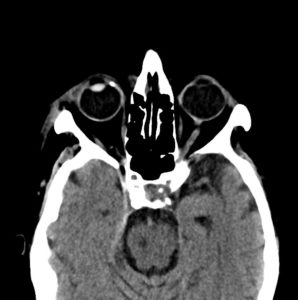Cataract risks associated with medical radiation among young patients, especially those coming from the neck and head CT scans, have been an issue of concern over the last few years. A number of studies have been conducted to determine cataract risks associated with repeated exposure to radiation from head CT scans. It has been argued that exposure to ionizing radiation raises the risk of cataract in patients, especially among children, however, this largely depends upon the area being scanned, and the eye lens dose exposed to the CT scan.

Where Did it Start?
It is common for children and young people to go through head CT scans for various reasons, and eyes are often involved in the IMB (infraorbital metal baseline) techniques and SMB (supraorbital-meatal baseline) positioning. According to previous studies, exposure of eye lens to such harsh radiations can result in cataract formation. However, there was confusion about whether the radiation is high enough to actually induce cataract, and if the dosage is reduced, will it influence the exam results.
What Did the New Study Revealed?
Once the issue arose, the researchers started analyzing head-region CT exams of children and young patients over a period of many years. In exams that included the eye, radiation dosages sent to the lens were between 20 and 75 mGy, and in exams that did not include the eyes, the dosage dropped to only 2 to 7 mGy.
After making these observations, researchers concluded that a majority of young patients going through head CT exams are likely to receive very small exposure to the radiation, causing cataract. However, this is the case with a limited number of scans only. Patients undergoing multiple CT scans using old equipment were exposed to several hundred mGy’s, especially in cases when eyes were involved in the scan. However, that does not mean that CT scans have caused cataracts in a large number of young patients. While involving eyes in the CT scans is advantageous for clinical reasons, the patient’s well-being is always the topmost priority. That means that most young patients who go through a CT scan of the head region are not given radiation enough to cause cataract.
Know Your Symptoms
If you are a child or young adult and you have to undergo head CT scans every now and then, then it is important for you to keep an eye on your symptoms and get a physician’s consultation as soon as you notice any of the following:
- Cataract starts small and you will not have any noticeable effects on your vision in the initial stages. However, things may seem blurry, dim or cloudy, and this effect may worsen over time.
- As the cataract advances, your vision starts getting a brown or yellow tinge. This significantly affects your vision at night, and you find it extremely difficult to study or drive at night.
- If the glare of lights causes pain in your eyes, then you must be having cataract that may increase your light sensitivity. Such cataract begins at the back of your lens, blocks the light path, and interferes with your nearby vision.
- Since lens clouding can diffract light entering the eye, you may start seeing halos around the lights. These halos may appear in the form of colorful rings around lights.
- If the strength of your eyeglasses or contact lenses keeps increasing every few months, then you may be having cataracts. If your eyesight is changing at a rapid pace, you may need to get your eyes checked for cataracts or any other eye condition.
- Since protein may cloud your lens, your vision may turn yellow or brown, due to which your perception of colors may change.
Who Are at Increased Risk of Developing Cataract?
Whether you are going through head CT scan or not, you have increased risk of developing cataract if you have any of the following conditions:
- If you spend too much time in the sun without wearing any eye protection
- If you smoke a lot
- If you have high blood sugar levels
- If you are using steroid medicines
- If you get exposed to radiation during the CT scans
You must know that cataracts are of three types, posterior subcapsular cataract, a nuclear cataract that happens in the lens center, and cortical cataract that appears on the side of the lens. However, it is important to understand that if you are having trouble in your vision, it may not necessarily be due to a CT scan you recently underwent. Some other factors, like a brain tumor, multiple sclerosis, stroke, corneal swelling, uncontrolled hypertension, and brain injury, may also cause vision changes.
We, at sepStream®, use advanced level high-quality imaging equipment only to ensure your safety and to receive accurate results in all aspects. We involve your eyes in the CT scans only if absolutely necessary, that too in very few doses so that the radiation does not cause any damage to your eye health and lead to cataract.